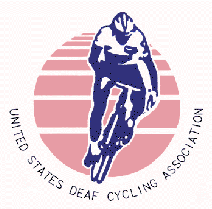United States Deaf Cycling
Association 
|
by Greg LeMond's Complete Book of Bicycling
1. Each morning, you check your waking pulse. Keep your finger on the pulse and stand up. This pulse check reveals how tired your body is from training the day before. When both first pulse or second pulse is unusual greater, it is clear signal of fatigue. If not, know you did not train hard enough! If it is unusual greater, you aren't ready for hard training. 2. Weight check-up daily! If there is no more fat to burn, so you will begin to lose muscle. Called "negative metabolism". It is not good idea to lose muscle.Senior Men should strive 3-4% body fat Senior Women should strive 6-8% body fat 3. 24 of age, your body development is complete and weight should stabilize. 4. Grade (A,B,C,D) on how you feel after you get up in the morning. If it is C or D and heart rate ( HR) is greater, you must change plan and ride easier! How to pick for your bike 1. "Tight Angles" mean very upright seat tube, therefore short wheelbase, lighter, stiffer, aggressive looking, the more responsive - ideal for sprint/time trial. 72.5 degree is mostly recommended. 2. Campagnolo is definitely an excellent product but very expensive! Other brands of alloy components will just do good. Campagnolo has pride name for cyclists. 3. Wheels: Moser (world record setter) liked heavy wheels. It increases centrifugal force, therefore momentum stays on time trial. 4. Hubs: low-flange hubs allow for a slight softer ride. High- flange hubs are stiffer. 5. Spokes: 32 spokes are highly recommended for racing, 36 spokes are good for training and 24-28 spokes are good for time trialling and pursuit. 6. Crossings: Crossings over is a way of significantly increasing the strength of a wheel. If soldered spokes, you have tough time to fix broken spokes. 24 is usually used for track that is run straight from hub to rim. 7. Rims: Clincher rim or sew-up rim? Clincher rim is far less expensive than sew-up rim. Fewer flats to fix and less messy! 100-120 psi Sew-up rims are choice of racers because of extremely light, responsive and easy to change but they are expensive and easily got punctured. 120 psi. On the long downhill, sew- up rims create problem when brakes are applied, they get heat-up and skid on the curve. 8. Crankset: Is the primary point of contact between rider and machine. 5 arm cranksets are more sturdier and rigid than fewer arms. Have to learn correct pedaling technique! 52 teeth is recommended for road race. 53-54 teeth is for time trialling with 175 mm arm. 9. Freewheel or cogs: 9-speed has become standard among the pro racers, but 7- speed unit will do fine. Steel freewheel is recommended over alloy/aluminum for more sturdier and dependable. 12-13-15-17-19-23 10. Front Derailleur: In French word! The machine that derails the chain. It should not rub on the chain otherwise it is wrong kind. 11. Rear Derailleur: is important that controls the change of gears. Expensive rear derailleur is recommended for durability and dependable function. 12. Pedals: is the synergetic link between man and machine. Toe straps are old fashioned but it is still good for track. Cleate is safer and quick release when fall. Toe straps sometimes cause poor blood circulation in feet. 13. Brakes: Good quality of brakes is a key for smooth stop. The soft rubber is much easier to stop than hard rubber. 14. Handlebars: Standard 40 cm bar is no longer practical. The wider bar is better for hard pushing when sprinting. Some handlebar has deep drop so you can rest on the top or ride on brake lever. When aerodynamic tuck, deep drop is appreciated. 15. Stem: Always alloy! 16. Saddle: Narrow is better. It has to be in the center tightened, not too far or back. 17. Seat Post: It is not good idea to drill the post because it supports 55% of your weight. 18. Frame: Better make sure that the it has blazed-on mounts on the down tubes and seat tube for bottles. Brake and gear cables go through inside the frame. 19. Shoes: Has hard sloe, light-weight and mesh for airing. You'd better wear your cycling socks first before you try out the shoes for fitting. 20. Tights: Good quality of tights is recommended because you will sit on the saddle for a long ride. No interference with blood circulation or body movement! It should be like a second skin. Lycra, chamois, gel, and good job of stitches! 21. Jersey: Preferred to be called "Swiss Tex" 22. Gloves: Human instinct is to throw out your hands to protect your body when fall. Good pair with cushion to absorb vibration/shocks. Also to ease your wrist! 23. Eye Wears: Of the old timers, eye wears seemed to be not important, but todays they do protect your eyes from cold, sand spill, insect and strain from the sun. 24. Helmet: Used to be not realistic for the Tour of France due to 5-6hours a day of constraining/heat. Wearing a helmet is a must.
Last updated: May 22, 2014 |